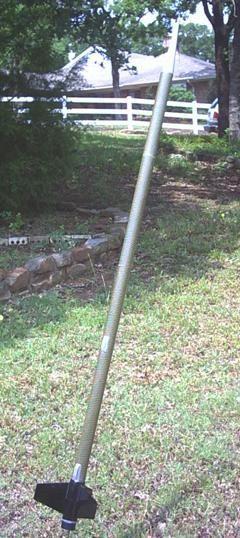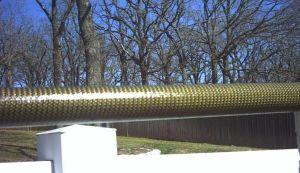Scratch Strickly Bizness Original Design / Scratch Built
Scratch - Strickly Bizness {Scratch}
Contributed by Dennis McClain-Furmanski
| Manufacturer: | Scratch |
Brief:
This is a Carbon/Kevlar composite laminated on Kraft paper tube, high
performance, almost minimum diameter scratch built rocket.

Construction:
Parts used:
- Two 34" BT-60 body tubes
- Two 4" C60 couplers
- 6' carbon/Kevlar® composite hybrid sleeve
- PML 1.5" urethane conical nose
- ACME 38mm fin can
- ACME conformal rail guides
- 38mm Slimline retainer and 38/29mm adapter
- 10feet of 5/16" tubular nylon shock cord
- 1/4" ply Bulkhead and 1/4" screw eye
- 1 foot of 1/4" Kevlar® wrapped elastic bungee.
- Nomex® chute protector
This rocket came about via experimentation with epoxy/composite sleeve lay ups. I found that single layer composite over Kraft tube is almost as strong as double layer composites, while being lighter and easier to do. Lamination was done with Epoxy Products premium no-blush epoxy and construction done with JB Weld.
Two 34" BT-60 tunes were covered with carbon/Kevlar® hybrid sleeve and laminated (see tutorial on Aerosleeve's web site for information on how to do this). After curing, a second coat of epoxy was applied to fill the weave. This was then finished with polyurethane coating and acrylic clear coat. The rough ends were trimmed off, resulting in two 30" tubes. 12" of one of these was cut off and a coupler and bulkhead (with screw eye epoxied in place) were used to create a payload section. The bungee was attached to the recessed screw eye to provide shock cord attachment with some shock absorption. The remaining tube and section were attached with a second coupler into a single tube. The shock cord was anchored by epoxying it between the coupler and the tube wall. A Nomex® chute protector was slid down the shock cord to the anchor. A knot and loop was tied into the end of the shock cord allowing attachment to the payload section via the same quicklink which held the selected chute's swivel.
 The
inner diameter of BT-60 is adequately close to 38mm airframe (41mm vs. 39.5mm
respectively) to require no adapting internally. After lamination, the outer
diameter required some sanding in order to get the fin can and Slimline
retainer to fit to be epoxied into place, however. this was not an easy
prospect with Kevlar®
composite cloth. An alignment line was drawn between two fins so the rail
guides could be epoxied to the tube. The Slimline 38/29mm adapter was
constructed with a longer piece of 29mm tube than provided so that very long
29mm motors (like the Ellis Mountain I69) could be used.
The
inner diameter of BT-60 is adequately close to 38mm airframe (41mm vs. 39.5mm
respectively) to require no adapting internally. After lamination, the outer
diameter required some sanding in order to get the fin can and Slimline
retainer to fit to be epoxied into place, however. this was not an easy
prospect with Kevlar®
composite cloth. An alignment line was drawn between two fins so the rail
guides could be epoxied to the tube. The Slimline 38/29mm adapter was
constructed with a longer piece of 29mm tube than provided so that very long
29mm motors (like the Ellis Mountain I69) could be used.
That's it. The construction took about 5 hours, which was far less than the 2 days needed to laminate and finish the tube. The result is a bulletproof high performance rocket using maximum strength but minimal build effort components, given that the tube was already laminated.
Finishing:
The fin can was painted with Rustoleum black appliance epoxy. The nose was
painted with white primer and aluminum finish enamel. Four 1/16" holes
were drilled in the payload section and the booster section for pressure
equalization. These were all retouched with acrylic coating to provide a smooth
finish.
Flight:
CP was calculated with AeroCP (approximately 1" in front of fin can). Cd
(average subsonic Cd = 0.587) and flight prediction was done with AeroDRAG.
Flight testing was done with an Aerotech 29/40-120 RMS motor in the 38/29mm Slimline adapter and G64-10W reload. CG was 4.5 calibers forward of CP with the adapter and motor in place.
No wadding was required due to the Nomex® protector. A Covert Recovery CR-3 chute was tied to a 1500lb swivel and attached to the shock cord and bungee with a 3/8" quicklink.
First flight was at Dallas Area Rocket Society's McGregor site in nearly calm winds. The flight was perfectly straight and vertical with ejection exactly at apogee. (Predicted apogee was at 1600' altitude at 9.6 seconds delay.)
Recovery:
Deployment and descent were without incident and the rocket was recovered
within 500' of the pad without damage.
Summary:
A big PRO was the successful use of composite sleeve laminated on common BT-60
Kraft paper tube to create a heavy duty almost 38mm minimum diameter rocket. A
CON was the fact that the laminated tube was slightly larger outer diameter
than 38mm airframe tube, requiring some sanding to fit. This was a CON
primarily because Kevlar®
is very hard to sand. A minor personal CON was the fact that carbon/Kevlar®
hybrid cloth does not finish up as pretty as pure carbon, but that's strictly a
cosmetic thing. The point was to build for strength, not looks.
 |
 |